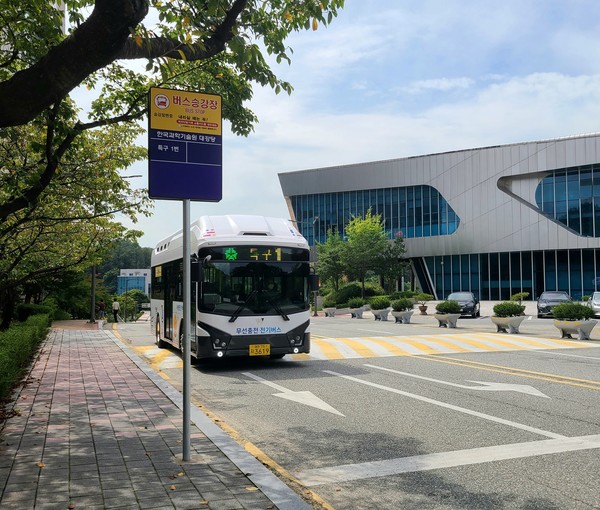On August 24, the Daedeok Special Zone Circular Bus No. 1 began its operation after a month-long delay due to a spike in COVID-19 cases. This is the first time public buses will pass through locations on campus. The new one-way route departs and terminates at the KAIST North Gate bus stop, located by the fMRI Center (N23). It circulates first around the Daedeok area, passes through KAIST to circulate the Wolpyeong and Bongmyeong-dong areas, then returns to campus at intervals of 40 minutes from 6 a.m. to 10 p.m. Bus stations have been installed in front of the Duck Pond, Main Administration Building (E14), Auditorium (E15), Educational Support Building (W8), and Basic Experiment and Research Building (N5).

The insufficiency of transportation options has consistently been identified as a major source of inconvenience for KAIST students. Many have pointed out that bus and metro stations are too far from most locations on campus and that previously implemented public bus routes outside of campus, as well as the school-operated shuttle buses to Wolpyeong, are limited in number and destination. As a result, most students resorted to taxis as their main method of transportation in and out of campus despite their lower affordability. Proposals regarding the addition or extension of bus and subway lines nearer to campus have been made for many years. Starting 2020, the KAIST Undergraduate Association (UA) and the Graduate Student Association (GSA) actively discussed this issue with the Daejeon city council, meeting with representatives of the Yuseong-gu residents, the district office, and the city and district councilors, as well as the KAIST General Affairs team.
For the student organizations, the convenience of the students was of foremost priority in deciding the route. They looked to confirm a route that passed through main transport and cultural infrastructure, such as Wolpyeong Station, the Express Bus Terminal, and the Daejeon EXPO area. However, according to the UA and the GSA, complications initially arose as “the interests of various organizations were intertwined,” and the city council was “more focused on the convenience of the general Daejeon citizens and lacked understanding of KAIST students’ needs.” The route first suggested by Daejeon city in March was, to a considerable extent, similar to the route of Bus 104 currently in operation. In addition, it circulated in a direction that took too long for students departing from KAIST to reach Wolpyeong and Gung-dong areas, which are common destinations for KAIST students. Continuous discussions and requests to select appropriate stops and directions that would improve student accessibility led to the current route. “We would like to once again thank the representatives of Yuseong-gu residents for willingly accepting students’ opinions,” Donghyeok Choi from the GSA remarked.
Moreover, the adaptation of “OLEV (On-Line Electric Vehicle)” technology in the new buses marked the onset of more sustainable public transportation alternatives. Developed at KAIST in 2010, the technology allows for wireless recharging of electric buses using electromagnetic induction between power cables embedded in the road and secondary coils attached on the vehicle. The lower battery and maintenance costs associated with these buses poses an economic benefit, alongside the environmental benefit of zero carbon emissions, aligning with Daedeok Innopolis’s “Eco-friendly Smart Experimental City” project.
The Daedeok Special Zone Circular Bus No. 1 is still in its trial stage — despite the single-direction route and the limited number of buses due to budget allocation, the UA and GSA note that the city council may further examine increasing the bus quantity and creating a two-way route if sufficient usage of the buses by students and staff is confirmed. Nevertheless, the opening of the new route is expected to encourage the use of public transport and significantly improve student access to facilities outside of KAIST.

